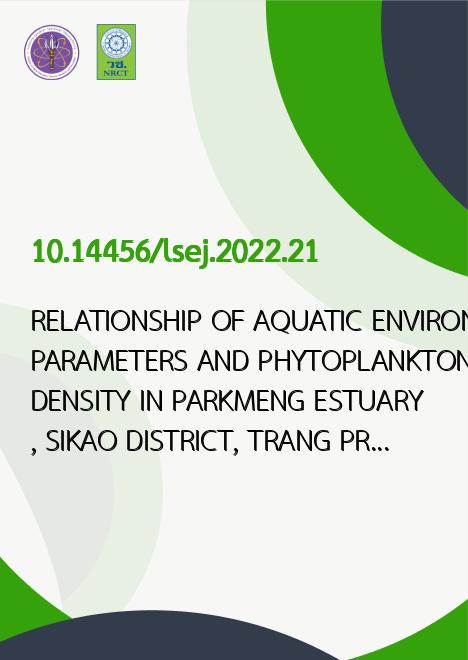
|
RELATIONSHIP OF AQUATIC ENVIRONMENTAL PARAMETERS AND PHYTOPLANKTON DENSITY IN PARKMENG ESTUARY, SIKAO DISTRICT, TRANG PROVINCE |
|---|---|
| รหัสดีโอไอ | |
| Creator | Patchara Pedprada |
| Title | RELATIONSHIP OF AQUATIC ENVIRONMENTAL PARAMETERS AND PHYTOPLANKTON DENSITY IN PARKMENG ESTUARY, SIKAO DISTRICT, TRANG PROVINCE |
| Contributor | Kieattisak Yokseng |
| Publisher | Pibulsongkram Rajabhat University |
| Publication Year | 2565 |
| Journal Title | Life Sciences and Environment Journal |
| Journal Vol. | 23 |
| Journal No. | 2 |
| Page no. | 271-282 |
| Keyword | Phytoplankton, Aquatic parameter, Relationship, Estuary, Andaman Sea |
| URL Website | https://ph01.tci-thaijo.org/index.php/psru/index |
| Website title | Life Sciences and Environment Journal |
| ISSN | 2773-9201 |
| Abstract | Parkmeng Estuary is located in Siako District area, Trang Province, the estuary is an important nursery area for marine life; however, port construction and tourist activities affect the estuarine environmental quality. It is necessary to study effect of those activities on the environment and biological qualities in this area. The relationships between aquatic environment parameters (AEP) and phytoplankton density in this estuary were investigated using the canonical correspondence analysis (CCA) method. The AEP was classified for two main seasons, monsoon (July-October) and summer seasons (November-April) by the unweighted pair group method with arithmetic mean analysis with similarity scores of 98.79% and 98.18%. The inter-change period was May classified by CCA score at 99.54%. Two divisions, 11 families, 14 genera, and 17 species of phytoplankton were recorded in this study. The division Chromophyta showed the highest density (74.96%) followed by Cyanophyta (26.04%). Similar to AEP analysis, phytoplankton was classified as monsoon or summer species with CCA similarity scores of 74.28% and 55.00%, respectively. Phosphate, conductivity, silicates, pH, and temperature showed correlations to phytoplankton density with CCA variable scores of 0.84, 0.75, 0.74, 0.72, and 0.71, respectively. This study reveals that the density of Triceratium sp., Rhizosolenia sp., Odontella sp., and Cyclotella stylorum diatoms might be used as bio-indicators for the fluctuations of salinity and pH in this estuary. |